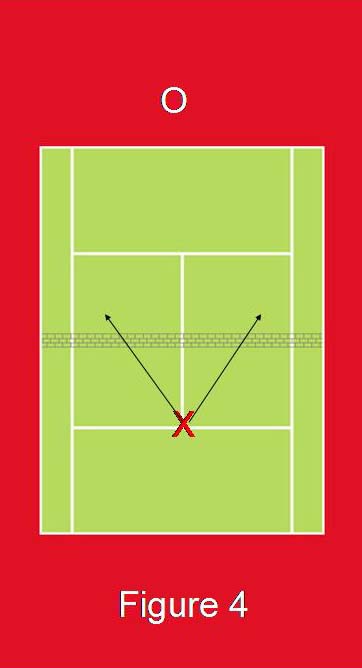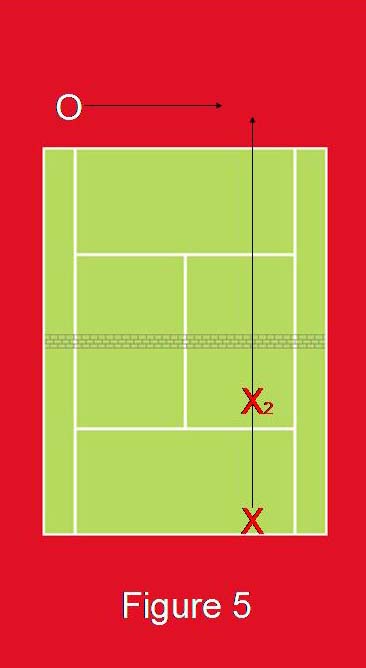June 2007 Article Turbo Tennis Archives:
Tennis Server
|

 |
Okay, let’s face it. Every time there is a Grand Slam event going on, we are just that much more eager to "play like the pros." Here in New England, it is obvious when a Grand Slam event is in progress. Go to any of the public courts and you will see many more people playing than would normally be the case. Frankly, I am no different. I find myself wanting to play more during the Grand Slam event times of year. Well, June has arrived and that means that Wimbledon will be the Grand Slam event garnering world attention. Although the All England Lawn Tennis and Croquet Club has done lots to make the surface slower (using a different type of grass), grass is still grass. Like indoor carpet surfaces, the serve/volley player is at a great advantage on these faster surfaces. By the finals of Wimbledon, the courts have been ravaged by play. The wear and tear is visible on television. This deterioration makes for faster play and unpredictable bounces.
The modern tennis tour professional is most likely to be a baseline-oriented, big hitting player. This trend has trickled down to all levels of the game. Granted Roger Federer is a superb serve/volley player as was the greats: Pete Sampras, Patrick Rafter, Tim Henman and Stefan Edberg. On the women’s side, we still see Martina Navratilova playing excellent serve/volley on the doubles side. One can’t forget Jana Novotna’s outstanding serve/volley game. Still, these are the exceptions, not the rule in the modern game. In fact, most modern players, from my perspective, have almost totally neglected their net games. I have watched pros take warm up volleys only to play a match where she/he never actually hits a volley. I suspect that, in part, the reason for the lack of net game play is due to the fact that modern players have difficulty getting to the net. Given the pace of serves and power of the modern groundstroke, it is hard to get to the net without being passed. Well, this month’s column is going to try to help you get to the net more often. I am not proposing that you play serve/volley or chip/charge tennis. But, every player should find opportunities to come to the net. The key is knowing when to come to net and how to approach the net. Before we go any further, it is important that you be able to volley! If you are uncomfortable volleying or really don’t have any volleys to speak of, you need to spend some extra practice time working on these essential strokes. To help you, I would refer you to two of my previous articles that address forehand and backhand volleying. You can get to these by going to these links: TURBOSTROKES: The Forehand Volley TURBOSTROKES: The Backhand Volley In addition to these volleys, you will need to be able to hit the one hand, slice backhand and be able to hit a forehand with topspin. I am presuming that each of these is in your arsenal, as they are usually part of the baseline player’s game. In the modern game, baseline players are taught to put away any short balls. This is not bad advice. However, sometimes the spin of an opponent’s shot makes these winners difficult to hit consistently. In addition, trying to hit winners off of your weaker wing is low percentage tennis. The only time some baseliners will find themselves at the net during a match is if the opponent has brought the player in. Pushers know that the big, banging baseliner probably doesn’t like to hit volleys. So, pushers are constantly hitting the short, dropping shots that can’t really be hit as clear winners. One of the goals of the pusher is to move the baseliner in and out with short shots and lobs. This is frustrating to the baseline player who is most comfortable moving left to right. I am appalled at the number of coaches who never really stress volleying to their charges. I grant you that serve/volley and chip/charge are not for many players. But, getting to the net at the right times is an important tactic in being truly competitive. Getting to the net is an integral part of the complete, modern player. In Figure 1 below, we see a situation that does not lend itself to approaching the net. Assume that you are Player X and your opponent is player O. You are given a ball to your backhand and decide to slice the ball down the line… following it to the net. Well, in this particular situation, you are likely to be losing the point. First, the ball that you are hitting is too deep in the court for an approach in the modern game. To approach safely, you need to have a ball that lands shorter in your court. Second, your opponent is inside the baseline and not too wide in his/her court. Thus, he/she can get to your shot with relative ease. When the opponent reaches your shot, he/she has lots of options. You are likely to be passed crosscourt at an angle that is so severe that you won’t get your racquet on the ball. The down the line pass is likely to work, as well, because the opponent can keep his/her shot low to the net with topspin and be certain that the ball will drop in bounds. Lastly, the opponent can hit an offensive lob (hit with topspin). You may try to get back to hit this lob, but the chances of you even getting a racquet on the ball are quite slim. All in all, you have nothing to gain by coming to the net in this situation. You are better off keeping the ball in play. If you have a great backhand, you may want to try a winning put away.
In Figure 1A, you are in a much better position to approach the net. First, the ball you are hitting has landed short in your court. Second, your opponent is deep and wide. She/he will need to scramble forward and to her/his right to make a reply. Usually, the opponent will be stretched when she/he hits the reply. If you have hit this approach shot with slice, the ball will stay low. The opponent will have a more difficult time hitting a rolling, crosscourt passing shot. In fact, my observations suggest that she/he will probably not even try for a crosscourt pass. The lob may be an option that she/he elects to hit, but again the low bounce of your sliced approach make a defensive lob (hit with backspin) more likely than the offensive lob. If this defensive lob is hit deep into your court, you will probably be able to get back and hit a lob of your own to stay in the point. However, the most frequent reply will be the down the line passing shot. Here however, the opponent must lift the ball more. Thus, the reply is likely to be higher over the net. Higher balls are much easier to volley than those that land at your shoestrings.
In Figure 2, we see an ideal situation. First you opponent is deep and wide in his/her court. Second, you are hitting a ball that is landing even shorter in your court. Lastly, I have tried to suggest a hard, deep landing sliced approach by making Player X’s trajectory line longer. Now, in the modern game, coaches would almost invariably instruct their players to go for a clear winning shot. Usually, the winning shot is hit flat or with topspin. This is not a bad strategy, but it has its own risks. For example, on a windy day, this normally easy winner may become an impossible shot to hit. Going for the deep, down the line, approach shot may be the better option. At least, it provides some variety to your play, which may keep your opponent guessing. Good opponents quickly learn when you will go for a winner and where you are likely to try and hit it. It doesn’t take long for a good opponent to read your pattern and anticipate your actions. I don’t have a killer backhand. It is not my best weapon. It serves me well as a rally stroke, and I hit excellent returns on this wing. But, trying to hit winning put away shots off this wing is not wise for me. However, I cannot tell you how many times I have won the point by approaching the net in the situation illustrated in Figure 2. My opponent rarely, if ever, hits anything but a reply that travels somewhat high over the net. In that the opponent is deep in his/her court, the angles for his/her reply are more narrow. If he/she tries for the cross court pass, almost always, the ball will land in the net. The lob is usually hit in a way that forces it to fall short in my court. Thus, I am left with an easy overhead for the winner. In my informal tallying, about 70% of the time, the opponent goes for the down the line passing shot. Thus, I am shading a bit in that direction as I move to the net. I can usually hit a very nice crosscourt volley that results in my winning the point.
In Figure 3, we see an ideal situation for an approach of the forehand side. Normally, the player in this situation will go for the put away winner that is hit somewhat deep and with lots of pace. This is not a bad tactic. Still, if the conditions are windy, you are probably going to miss a few of these "sure things." If your opponent has fed you a ball that has little pace and/or lots of slice, your put away may, again, be less than reliable. Frequently, in this situation I will hit either a soft rolling, topspin shot, or at times, I will opt for a crosscourt stop volley. I admit, however, that the latter is more risky. But, I have a really good forehand, stop volley. I am confident with it, and hit it with lots of margin for error. Regardless of which way I hit my forehand in this situation, I will follow my shot to the net. Frequently, I can hit this approach from a deeper position than shown in the Figure 3, and still make a decent approach. Why? Well, my opponent is deep and has lots of ground to cover. If I hit the roller, I try to move to cover my opponent’s down the line shot. If I hit the stop volley, I am looking for the opponent to flick a half volley cross court. Lobs in this particular situation are extremely difficult to hit…defensively or offensively. So, it is rare that I see these. If I do, I just tip my hat to my opponent.
Figure 4 illustrates what I call the "pusher" opportunity. Frequently, pushers will hit a short ball right in the center of the court. They usually do this when they are in the center of the court, and I am expecting a rally shot. Pushers are to be respected. They will hit that short, no paced, backspin dink over and over again! The unfortunate baseline player with all the big shots will invariable try to hit a powerful winner. Frequently, she/he will miss the winner by hitting wide or deep. At other times, the pusher will anticipate where the winner is going to be hit and get there in time to hit a passing shot. I cannot tell you how many times I have seen skilled players fall victim to this pusher’s tactic. Well here again, I would suggest that the wise player attempt to hit a bit of an approach shot off of this dink. The idea is to just ease the ball off to either side as seen in Figure 4. Then, it is important to keep moving into the net favoring the side to which you hit your shot. Do not expect that this soft, angled shot will not be returned. Pushers will surprise you! If the pusher gets to the ball, you will be ready to hit a volley for a winner, if you have kept moving forward to the net.
Lastly, we have Figure 5. In this situation, we are presented with a somewhat similar situation as presented in Figure 2… only on the forehand wing. However, you will note that in Figure 5 you (Player X) are hitting a down the line shot from a relatively deep position in the court. In this situation, you want to hit a hard, topspin shot as your approach! Your opponent is out wide and the pace that the topspin shot will force her/him to have to scramble to get to the ball. In addition, the topspin will allow you to clear the net (which is higher) with greater certainty that the ball will drop in bounds. You will see that I have identified position X2. This is where you want to be after you have hit your down the line approach. I will leave the crosscourt pass open to my opponent. Usually, the opponent is very stretched, unless the surface is clay. He/she will not be able to make the crosscourt pass. The pros on the tour may be able to achieve this feat, but this is not to be for us mortals. Lobs can be hit by the opponent in this situation, but they are almost always hit with backspin (defensive) and frequently they land very short. Since I have to move to my left and I am right handed, I often times, let the lob bounce before hitting my overhead. This gives me extra time to get to the lob. Most frequently, the opponent will try to hit something with pace that is directed at right at me. I am ready with a block volley that sends the ball crosscourt. I make certain that I don’t have any swing to my volley. I simply try to block the ball wherever it may pass over the net.
So, you hopefully can see that there is a place for volleys in your game plan. You can actually execute a two step plan: Hit a good approach and be ready to hit a winning volley. If you are playing on an advanced level, be prepared to hit two volleys before the point is won! People will often ask me, "How should I move when I approach the net? Where should I be standing to volley?" Well, the answer is very simple. Just follow the path of your approach shot and shade a little toward the open court. There isn’t any great thought that has to go into this, and yet, it almost always puts you in the most ideal position to return any possible replies. So, you are probably wondering why I entitled this column "Smell the Net?" This is a phrase that a friend used to describe the net mentality. The goal is to always keep moving forward when approaching and after volleying. As soon as I hit my approach, I literally say to myself, "Smell the net, Ron." Many of us, including myself, are not natural serve/volley players. As groundstroke, baseline players, our whole mentality is based on power and left/right movement. Well, all of us can incorporate volleys into our overall game plan. We don’t have to approach a lot during a match. But, if we are aware of the right times to try, we can win some points that will keep our opponent honest. Predictable play results in losing matches. Baseliners are very common. I know. I am one of them. But, the danger is that our patterns of play may become known to our opponents. Once this is revealed, the opponent has the advantage of anticipation. When our opponent is anticipating our play, we usually try to hit harder, not smarter. Well, incorporating an approach game into your repertoire will provide you a means of varying your play and keeping the opponent off guard. Practice your approach game and I assure you that in no time you will become a tennis overdog!
1996 - 2002 | 2003 - Present
This column
is copyrighted by Ron Waite, all rights reserved. Questions and comments
about these columns can be directed to Ron by using this form.
Ron Waite is a certified USPTR tennis instructor who took up the game
of tennis at the age of 39. Frustrated with conventional tennis methods
of instruction and the confusing data available on how to learn the
game, Ron has sought to sift fact from fiction. In his seven years of
tennis, Ron has received USTA sectional ranking four years, has successfully
coached several NCAA Division III men's and women's tennis teams to
post season competition, and has competed in USTA National singles tournaments.
Ron has trained at a number of tennis academies and with many of the
game's leading instructors.
In addition to his full-time work as a professor at Albertus Magnus
College, Ron photographs ATP tour events for a variety of organizations
and publications. The name of his column, TurboTennis, stems from his
methods to decrease the amount of time it takes to learn and master
the game of tennis.
|



October 2022 Tennis Anyone: Patterns in Doubles by John Mills. September 2022 Tennis Anyone: Short Court by John Mills. |
 You will join 13,000 other subscribers in receiving news of updates to the Tennis Server along with monthly tennis tips from tennis pro Tom Veneziano.
You will join 13,000 other subscribers in receiving news of updates to the Tennis Server along with monthly tennis tips from tennis pro Tom Veneziano. 






